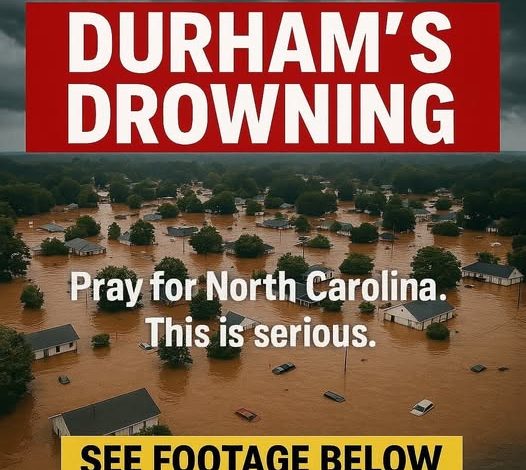
Downtown Durham has been transformed into a vast, churning expanse of water as relentless thunderstorms have turned familiar streets and quiet residential blocks into raging rivers. Once-bustling sidewalks now lie submerged beneath torrents of muddy water, and the hum of city life has been replaced by the eerie roar of currents and the distant blare of emergency sirens.
Social media is flooded with raw, heart-stopping footage: terrified residents clambering onto rooftops, waving desperately for rescue teams; cars bobbing helplessly before being swept away like driftwood; entire blocks swallowed by the flood, their outlines only faintly visible beneath the murky surface.
First responders have been working around the clock, deploying rescue boats and helicopters wherever the deluge allows, yet many neighborhoods remain cut off by swirling whirlpools that make boat access nearly impossible. In these isolated pockets, families cling to rafters and rafters of hope, signaling with flashlights, towels tied to poles, or anything that might catch the attention of a passing aircraft. Power outages have plunged whole districts into darkness, severing vital communication lines just when they’re needed most. With battery reserves dwindling, residents are urged to conserve energy, stockpile supplies, and stay off flooded roads.
Inside flooded homes, the devastation is devastatingly intimate: living rooms awash in chest-high water, sofas and appliances drifting like barges; children’s toys floating aimlessly along waterlogged carpets; family pets paddling to stay afloat. Medical emergencies have grown dire, as paramedics struggle to navigate submerged streets and hospitals brace for an influx of critically ill or injured patients. Officials have issued evacuation orders for the hardest-hit zones and opened temporary shelters in universities and community centers still on dry ground.
Despite the enormity of the crisis, national media presence has been surprisingly light, leaving Durham’s residents to rely on each other and social platforms for real-time updates, grassroots rescue coordination, and pleas for external assistance. Neighbors have organized impromptu relief networks—sharing food, clean water, warm blankets, and safe passage through chest-deep water. Volunteer boat drivers ferry the elderly and infirm to makeshift shelters, while community groups deliver life-saving medications to those stranded.
City authorities continue to monitor rapidly rising water levels and issue urgent bulletins: stay indoors if possible, avoid any travel, and heed all official instructions. When the rain finally subsides and the waters recede, Durham will confront an immense recovery effort—clearing debris-clogged streets, restoring power and clean water, repairing damaged homes and businesses, and providing long-term support to families who have lost nearly everything. Yet even amid this calamity, the solidarity of Durham’s residents shines through—a testament to resilience in the face of nature’s fury and a shared belief that, together, they will rebuild stronger than before.